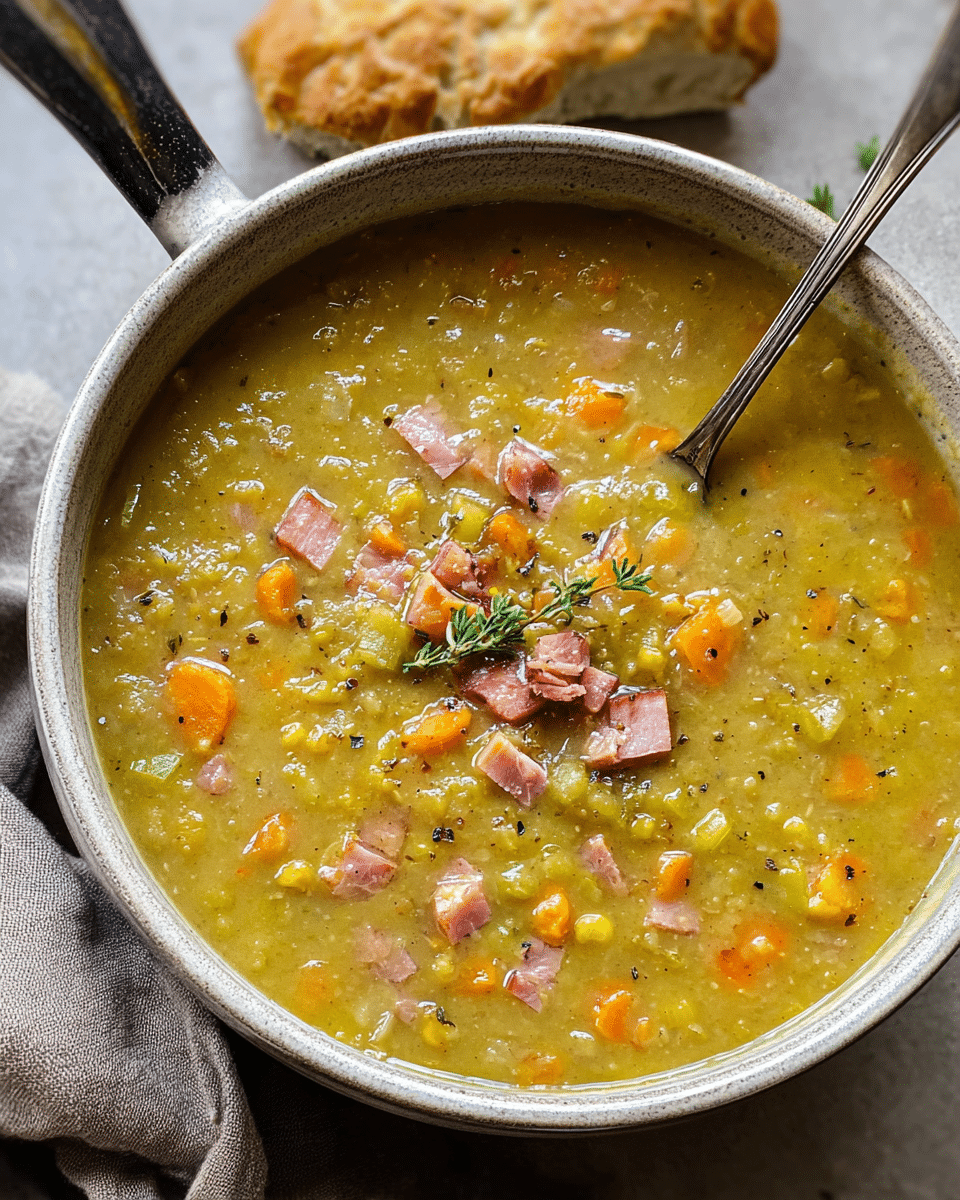The aroma of Split Pea Soup with Ham simmering on the stovetop evokes memories of family dinners and comforting meals shared around the table. With tender split peas, savory ham, and aromatic vegetables, this one pot wonder is both satisfying and nutrient-rich.
Perfect for cooler evenings, this soup delivers rich flavor and hearty texture with minimal effort. Whether you’re serving it with crusty bread or enjoying it on its own, it’s a classic that never goes out of style. Make a big batch it tastes even better the next day.
Full Recipe:
Ingredients:
-
1 pound dried split peas
-
1 ham hock or 2 cups diced ham
-
1 onion, chopped
-
2 carrots, diced
-
2 celery stalks, diced
-
3 cloves garlic, minced
-
6 cups chicken broth
-
1 teaspoon dried thyme
-
1 bay leaf
-
Salt and pepper to taste
Directions:
-
Rinse the dried split peas thoroughly under cold water and set aside.
-
In a large pot, heat a tablespoon of oil over medium heat. Sauté the onion, carrots, and celery for about 5–7 minutes until softened.
-
Add the minced garlic, dried thyme, and bay leaf. Cook for another minute, stirring frequently.
-
Add in the rinsed split peas and ham hock or diced ham. Pour in the chicken broth and bring the mixture to a boil.
-
Once boiling, reduce heat to low. Cover the pot and simmer for 1 hour, stirring occasionally.
-
If using a ham hock, remove it, shred the meat, discard the bone, and return the meat to the soup.
-
Season with salt and pepper to taste. Serve warm.
Prep Time: 15 minutes | Cooking Time: 1 hour 15 minutes | Total Time: 1 hour 30 minutes
Kcal: 250 kcal | Servings: 6
The Ultimate Guide to Split Pea Soup with Ham: Comfort in a Bowl
Few dishes provide the kind of nostalgic warmth and deeply satisfying flavor that a bowl of split pea soup with ham delivers. With humble origins, this hearty soup is a shining example of how simple ingredients, when combined with care and slow cooking, can transform into a soul-soothing meal. Whether you’re savoring it on a chilly evening or meal prepping for the week, split pea soup with ham is a timeless classic that never fails to comfort and nourish.
In this article, we’ll explore the background of the dish, its health benefits, serving suggestions, storage tips, and variations that allow you to put your own twist on the recipe. So, let’s dive into the story and soul behind this beloved comfort food.
A Humble History
Split pea soup has roots stretching back thousands of years. Ancient civilizations in Greece and Rome used dried peas as a staple, thanks to their long shelf life and nutritional value. In fact, the modern split pea soup that we know today finds influences in both European and American culinary traditions.
In countries like the Netherlands, a thick, hearty version known as “erwtensoep” is popular during the winter, often served with rye bread and sausage. In the United States, split pea soup gained popularity during colonial times when settlers adapted European methods to local ingredients. The addition of ham often a leftover from a holiday roast or ham hock became a flavorful, economical way to infuse the soup with smoky richness.
Today, this dish is loved not only for its taste but also for its comforting aroma and filling, nutritious qualities.
The Comfort of Cooking Slowly
There’s a reason this soup is associated with comfort. The process itself is calming: rinsing the split peas, chopping fresh vegetables, letting everything simmer slowly over low heat. As it cooks, the aroma of garlic, thyme, and savory ham begins to fill the kitchen, wrapping the space in warmth and anticipation.
What’s beautiful about split pea soup is how it evolves during the cooking process. The peas slowly break down, creating a naturally creamy texture without the need for added cream or flour. The ham contributes depth and smokiness, while the vegetables provide sweetness and balance.
For many home cooks, this soup is a go-to during the colder months or when seeking a restorative dish that feeds both body and soul.
Nutritional Benefits
Aside from being comforting and delicious, split pea soup with ham is also a powerhouse of nutrition. Split peas are high in fiber and plant-based protein, making this soup satisfying and heart-healthy. They’re also a great source of important nutrients such as:
-
Iron – for red blood cell production
-
Magnesium – which supports muscle and nerve function
-
Potassium – to help balance blood pressure
-
B-vitamins – for energy and metabolism
Adding ham contributes additional protein and essential minerals like zinc and phosphorus. While some versions can be high in sodium depending on the broth or ham used, it’s easy to control seasoning at home to create a balanced, health-conscious meal.
A typical serving of split pea soup with ham contains around 250–300 calories, 14–20 grams of protein, and a generous amount of dietary fiber up to 13–15 grams per bowl. That makes it an excellent option for those looking to eat clean without sacrificing taste.
Serving Suggestions
Split pea soup with ham is a stand-alone star, but a few thoughtful accompaniments can turn it into a complete meal experience. Here are a few ideas:
-
Crusty bread or baguette: The classic pairing. Perfect for dipping into the creamy soup.
-
Herb garnishes: A sprinkle of fresh parsley, thyme, or green onions can brighten up the flavors.
-
Sour cream or crème fraîche: A small dollop can add a rich tang to balance the soup’s earthiness.
-
Side salad: A light green salad with vinaigrette makes a refreshing contrast to the hearty soup.
It’s also a fantastic make-ahead dish for weekly meal prep. It reheats beautifully, and the flavors deepen after a day or two in the fridge.
Variations to Try
One of the best things about this recipe is its adaptability. Whether you’re catering to dietary needs or just looking to explore new flavors, here are some creative variations:
1. Vegetarian Split Pea Soup
Skip the ham and use vegetable broth. Add smoked paprika or liquid smoke for that deep, savory flavor without meat.
2. Slow Cooker or Instant Pot Version
These time-saving methods make it even easier to prepare. In the slow cooker, it can cook all day while you’re at work. In an Instant Pot, the soup is ready in about 30 minutes under pressure.
3. Add Grains
Stir in cooked barley or wild rice to boost the fiber and create an even heartier texture.
4. Add More Veggies
Spinach, kale, or even sweet potatoes can be added toward the end of cooking to elevate the nutritional profile.
5. Spiced-Up Version
Try adding cumin, curry powder, or chili flakes for an unexpected twist. These spices work surprisingly well with the mild, earthy base of split peas.
Common Mistakes to Avoid
Despite being a relatively simple recipe, there are a few common pitfalls that can affect the soup’s quality. Here’s what to watch out for:
-
Skipping the rinse: Split peas should always be rinsed before cooking to remove debris and reduce bitterness.
-
Overcooking: While the peas should break down, simmering too long or on too high heat can cause the soup to become overly thick or scorch at the bottom.
-
Under-seasoning: The soup is naturally mild, so be sure to taste and adjust seasoning before serving.
-
Adding acidic ingredients too early: Ingredients like tomatoes or vinegar can prevent the peas from softening properly if added too soon.
Storage and Reheating Tips
Split pea soup with ham is a dream for leftovers. After it cools, store it in an airtight container in the refrigerator for up to 4 days. It also freezes well just portion it into freezer-safe containers, and it will keep for up to 3 months.
When reheating, you might notice that the soup thickens significantly in the fridge. Simply add a bit of water or broth as you warm it up on the stove or in the microwave to bring it back to the desired consistency.
Conclusion:
Split pea soup with ham is more than just a meal it’s a tradition passed down through generations, a simple dish that speaks volumes about home, warmth, and nourishment. Whether you’re making it with leftover holiday ham or starting from scratch with a meaty hock, the results are consistently delicious and satisfying.
Beyond the flavor and texture, it’s a practical recipe that aligns with budget-conscious cooking, healthy eating, and the joys of preparing something slowly and mindfully. It’s adaptable, deeply comforting, and perhaps best of all welcomes creativity in every pot.
So the next time you crave something hearty and wholesome, remember this bowl of comfort. You may just find it becomes a staple in your kitchen for years to come.






